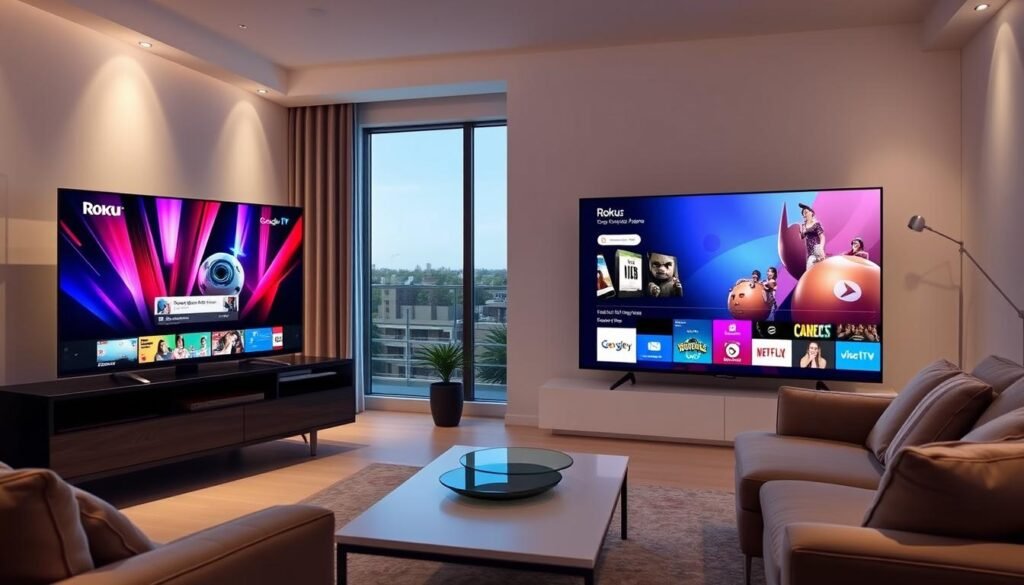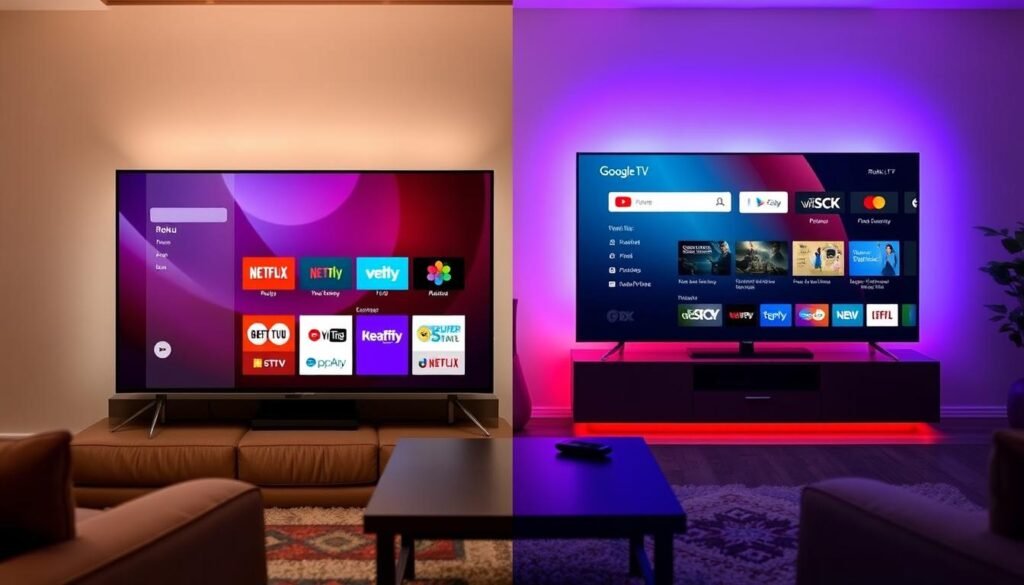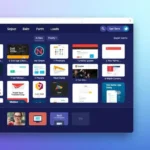Roku TV vs Google TV: Many people have gone through the comparison. Understanding them here is essential for those who want the most optimized viewing experience.
Roku TV is probably the most essential player in the streaming device market, with over 80 million users. Google TV Is Slowly Improving — But We Need a Lot More_HEADERS The same cannot be said of Google TV, the updated Android TV lineup that continues to be sluggish. However, it is equipped with various functionalities that make it quite popular.

Key Takeaways
- Roku TV has a 48% share of the TV OS market, making it a top choice for smart TVs.
- Google TV, like most of the Google services, is compatible with Google Assistant, and there will be a good variety of apps and services available.
- Roku TV’s interface is easy to use, while Google TV offers more personalization and customization.
- Both platforms have large content libraries. Roku TV has nearly 40,000 apps, and Google TV has over 8,000 streaming apps.
- Picture and sound quality are similar. Both support 4K, HDR, and Dolby technologies.
Introduction
The Roku TV: Google TV rivalry shows how smart TV platforms are never settled. Roku OS is the operating system for Roku TV, and Google Android TV OS is in charge of its end. They are the two most dominant players in smart TV today.
The different platforms come with their own special features, content, and UX. This article will help you learn these differences so you can make the best decision.
Roku TV and Google TV: Prominent Contenders
Google TV came out in 2020, bringing new tech to streaming. It uses machine learning to provide better content suggestions. Roku TV, known for its wide range of free channels and streaming services, is also easy to use and affordable.
Roku offers sticks, boxes, and smart TVs from partner brands. Google TV works with Chromecast, Android TV devices, and some smart TVs. Both platforms work well with certain smart TVs.
“The decision between Roku and Google TV ultimately depends on individual needs, budget considerations, and preferences for various features and interface aspects.”
As the competition goes on, users will get to see what each platform offers. They have the choice to make one that better fits their needs and desires.
Key Features: Roku TV
The interface and navigation of Roku TV are extremely user-friendly. Now, this is something viewers absolutely adore. The app support is truly remarkable, and there is Netflix, Hulu, Amazon Prime Video, and many more. Also, The Roku Channel is worth more than 350 free streaming guests, so it is possible to exist without the subscription of any other devices.
User Interface and Navigation
The interface of the Roku TV has been crafted with the intention of ease of use and hence can be easily operated. You are able to search for your favorite shows and movies very fast, and with the option of regular updates, all the newest features are always on hand.
App Selection and Content Library
The assembly hopes that Roku, at present, commendably boasts an appearance of an expansive content library, including The Roku Channel, which offers more than 350 free live TV channels. Additionally, Roko TV also has a variety of popular apps for streaming movies and series and even live news and sports channels.
“Roku TV’s intuitive interface and vast app selection make it a top choice for those seeking a seamless streaming experience.”
Key Features: Google TV
No two ways about it; Google TV offers some nice convenience points. Delivers content specific to where and how the moment is shared. — It is compatible with smart homes. The For You feature gives you content that is tailored to what you would like. You can also use your voice for the TV and house operations on Google TV.
Personalized Content Recommendations
Google TV’s recommendations are tailored to your viewing habits and preferences, making the ‘For You’ section a personalized gateway to new and interesting content. This feature ensures you always have something to watch that suits your taste.
Voice Control and Smart Home Integration
Google TV’s voice control is powered by Google Assistant. You can search, adjust volume, and control smart home devices with just your voice. This makes using Google TV easy and convenient.
The features of Google TV, particularly its personal content recommendation system and its voice control, can be credited to why the users do not go for other devices.”
Roku TV vs Google TV: Ease of Use
Both Roku TV and Google TV are easy to use but in different ways. Roku TV is simple and easy to navigate, perfect for those who like a basic smart TV. Google TV, on the other hand, offers a more personalized and feature-rich interface. It’s great for users who want a customized smart home experience.
The Roku TV interface is a television that is pleasing to the eye and easy to use. It enables viewers to search for their preferred telecasts and enjoy them in no time. Users prefer the Google TV interface since it is quite appealing and attractive. It has content tailored to the user based on their viewing habits.
- One of the strengths of Roku TV is the simplicity of its interface, which makes it very appealing to most first-timers and the elderly.
- Google TV is more convenient and has more functions, so it can be adjusted by the user compared to other smart TVs, which is beneficial for users who would like more control over the operation of the smart TV.
- The attractive aspect of the Roku TV is the straightforward approach used in navigation and the emphasis on getting the right content in the shortest time possible.
Google TV users who are comfortable with Google Assistant and other Google services expect more noise in smart home products and services integration.
In the end, it all comes down to the personal preferences of the users when it comes to holding together between Roku TV and Google TV. If you want a normal smart TV that is mainly focused on users who want simplicity, then you might prefer a Roku TV. On the other hand, if you want every aspect of the smart TV experience that is customizable in every way that an individual wants, including more features, a Google TV may be the best bet.

Roku TV is straighter as it is for normal people with little or no computer knowledge; Google TV expands depending on the person looking after that TV and all the features available on the web.
Content Access and Application Choice
The rivalry between the two media systems, namely Roku TV and Google TV, with regard to content plus the variety of apps, is thrilling. It is worth noting that Roku TV supports around 40,000 channels and apps, giving users an enormous selection. This is still a lot yet less than what Roku TV offers as Google TV, though on the rise, has over 8,000 apps.
Selection of Apps Available on Roku TV
No doubt, there are great deals of apps available on the Roku TV app store that satisfy lots of user expectations. Among them are famous movie services that are directed to the consumer, such as Netflix, Hulu, and Amazon Prime. Furthermore, more than 100,000 episodes of different TV series and movies are provided, which guarantees that there is always something to watch.
Google TV’s Growing App Ecosystem
Google TV’s app library is not as big as Roku TV’s but is getting bigger. It comes on smart TVs from Chromecast, Sony, Hisense, and TCL. Users get access to over 10,000 apps and a content library for different tastes.
Google TV also works well with Google services like YouTube and Google Assistant. This might make up for the fewer apps for some users who value easy integration and personalized suggestions.
Picture and Sound Quality
Roku TV and Google TV both offer great picture and sound quality. They support 4K resolution, HDR, and Dolby audio. This makes for a better viewing and listening experience.
The Roku Ultra is Roku’s top streaming device. It supports 4K, Dolby Vision, and Dolby Atmos. This means you get amazing picture quality and 3D sound.
The Chromecast with Google TV 4K also has 4K, HDR10+, and Dolby Vision. Plus, it has Dolby Atmos audio. This makes for a great viewing and listening experience.
Different Roku TV and Google TV models may have different levels of support. But overall, the picture and sound quality are excellent. Roku TV’s Pro Series, for example, has a 120Hz refresh rate and Dolby Atmos audio. It also supports up to 4.1 surround sound.
“The picture quality on my Roku TV is simply stunning. The 4K and HDR support make everything look so vibrant and detailed.”
Google TV also offers great picture and sound quality. Its devices, like the Chromecast with Google TV 4K, support the latest technologies. As a result, high-quality viewing (with excellent picture and sound) on any device is made possible for its users.
Putting it all together, Roku TV and Google TV offer superior sound and picture quality. It also supports 4K, HDR, and Dolby, among other latest technologies. While exact features may differ, both stand to have a solid visual and audio experience.
Smart Home Integration and Voice Control
Google TV is a clear winner when it comes to smart home integration and voice control. It integrates well with the Google ecosystem. This lets users control their TV and smart home devices with just their voice.
Google TV’s voice control is a big plus over Roku TV. Roku TV only supports voice control through third-party apps. With Google TV, you can change the lights, adjust the temperature, or play music with your voice.
Google Assistant on Google TV also brings advanced features. You can get personalized content, control your smart home, and multitask easily. All of this is done with just your voice.
Roku TV’s voice control is not as strong. It relies on third-party apps, which may not work as well as Google TV’s Google Assistant. This makes Google TV a better choice for those who want a fully connected and voice-enabled home.
Roku TV vs Google TV: Device Compatibility
There are variations in the device compatibility of Roku TV and Google TV. Most smart TV manufacturers, such as TCL and Hisense, support Roku TV. It also works with streaming devices from Roku. This takes the Roku TV to many people.
Google TV, however, is restricted, with many people putting it on their TVs – predominantly Sony, Hisense, and TCL. Also, it is compatible with devices like Chromecast and Google TV. For such people, this could be a disadvantage.
Roku TV: Broad Device Support
Roku TV is known for its wide compatibility. It has a 48 percent share of the TV OS market. This makes it a big player in smart TVs, with over 80 million users.
Google TV: Limited to Select Brands
Google TV was introduced in 2020 with the Chromecast with Google TV. It uses Android TV OS and offers many apps and services. But, it only works with a few TV brands, like TCL.
“Google TV’s tight integration with the other Google products makes it easier for users to harness the capabilities of a smart home by providing them with a more holistic and connected experience.”
Privacy and Advertising Concerns
The fight between Roku TV and Google TV has raised questions about privacy and ads. Both offer lots of content and ease, but users must think about privacy and personal data. It’s a balance between wanting personalized content and keeping data safe.
Roku TV’s Intrusive Advertising
Roku TV is renowned for showing commercials, which can be quite tiresome. The platform employs advertisement in order to generate revenue. It collects information about content and searches in order to customize the ads, which ends up being very annoying.
Google TV’s Data Collection Practices
Google TV is known for being smooth and tailored to you, but it also collects a lot of data. It watches what you search for and what videos you watch. This data helps make recommendations and ads more relevant to you.
If you’re worried about privacy and data collection, think about how much you’re okay with ads and sharing data. Both Roku TV and Google TV let you control ads and data. But how much control you have and how clear it is can differ.
“As smart TV platforms continue to evolve, the tension between personalization and privacy will only intensify. Consumers must be vigilant in understanding and managing their data footprint on these devices.”
Pricing and Value Proposition
Both Roku TV and Google TV have unique goods and pricing models that will suit a wide variety of consumers and their tastes with respect to pricing and value propositions. The Roku Streaming Stick 4K costs $49.99, and the Chromecast with Google TV is also $49.99. This makes them both great choices for starting your smart TV journey.
The Roku Streaming Stick 4K supports Dolby Atmos and other audio formats. The Chromecast with Google TV also supports Dolby Atmos and other formats. Both support Dolby Vision and HDR10/10+ for video.
The Roku Streaming Stick 4K is quicker to load apps than the Chromecast with Google TV. The Chromecast and Google TV show live TV channels from YouTube TV and Sling TV on its home screen. The Roku Streaming Stick 4K has a Live TV Zone for free TV channels from The Roku Channel.
In the end, both Roku TV and Google TV are great choices. The Roku Streaming Stick 4K scored 84 points, and the Chromecast with Google TV scored 83 points. Think about what you need and how much you want to spend to find the best fit for your home.

Conclusion
Two of the best smart TV platforms out there are Roku TV and Google TV. Roku TV, because it is simple and universal, many modern devices can be connected to its input. Google TV, on the other hand, is more accurate at using a voice-based interface, and it provides personalized suggestions and smart home features.
Roku TV vs Google TV, if you do have to make a choice, is what matters most to you. Is simplicity, apparently no-brainy apps, and ease of setup what you want? Or do you prefer tailored media voice control with smart home integration? These differences make you an educated consumer.
Roku TV vs. Google TV: Who wins? Smart TV platforms continue to be better, and Roku TV and Google TV both have their advantages. Which one of them you choose is up to your requirements and what you use. If you prefer the easy use of Roku TV or the personalized-for-you experience that Google TV offers, there’s a sweet spot for every streaming viewer.
FAQ
What are the key differences between Roku TV and Google TV?
Roku TV and Google TV differ in several areas. Roku TV is known for its easy-to-use interface and wide range of apps. Google TV, on the other hand, offers a more personalized experience with better voice control and smart home integration.
Which platform has a better app selection and content availability?
Roku TV has nearly 40,000 channels and apps, while Google TV has over 8,000. Google TV’s connection to the Google ecosystem might make up for this difference for some users.
How do Roku TV and Google TV compare in terms of user experience and ease of use?
Both platforms come with their simplicity; however, they come in different aspects. Roku TV is very elementary and hassle-free. Google TV, on the other hand, offers a different approach where personalization is offered, and this could be a selling point for people who wish to have a smart mediator with an arranged home.
Does Roku TV or Google TV have better smart home integration and voice control capabilities?
Google TV excels in smart home control and voice commands thanks to its integration with the Google ecosystem. Roku TV only supports voice assistants through third-party integrations.
How do Roku TV and Google TV compare in terms of device compatibility?
Roku TV works with many smart TV brands. Google TV is mainly found on TVs from Sony, Hisense, TCL, and Chromecast with Google TV devices.
What are the privacy and advertising concerns with Roku TV and Google TV?
Roku TV has intrusive ads, while Google TV has raised privacy concerns due to its data collection. Users should think about their comfort with ads and data privacy when choosing.
How do the pricing and value propositions of Roku TV and Google TV compare?
Roku TV is often in more affordable smart TVs. Google TV is usually in pricier models. It’s important to consider the features, performance, and cost of each to find the best value.
Source Links
- Google TV vs. Roku TV: Which Is the Better Streaming OS? | Digital Trends – https://www.digitaltrends.com/home-theater/google-tv-vs-roku-tv/
- Google TV Vs. Roku: Which Is Best In 2024? – SlashGear – https://www.slashgear.com/1635372/google-tv-vs-roku-which-is-best/
- Google TV vs Roku | Which Is the Better Streaming Device? – https://www.electronicshub.org/google-tv-vs-roku/
- Google TV vs Roku: Which Is The Best Streaming Device? – https://beebom.com/google-tv-vs-roku/
- Roku vs Google TV: which OS is best for your next smart TV? – https://www.yahoo.com/tech/roku-vs-google-tv-os-090048122.html
- Google TV vs. Roku: Choosing the Best Streaming Device | Geekflare – https://geekflare.com/consumer-tech/google-tv-vs-roku/
- Google TV vs Roku: Comparing Key Features for Digital Signage Efficiency – https://www.pickcel.com/blog/google-tv-vs-roku-tv/
- Google TV vs. Android TV: Choosing Your Smart TV Experience – https://us.seenebula.com/blogs/how-to-select/google-tv-vs-android-tv
- Roku TV vs. Google TV | All West Communications – https://www.allwest.com/blog/roku-tv-vs-google-tv/
- What is the Difference Between Google TV & Roku TV? – https://vronns.com/technology/google-tv-vs-roku-tv/
- Which Smart TV Should You Buy: Roku, Fire, or Google – https://www.howtogeek.com/119734/which-smart-tv-should-you-buy-roku-fire-or-google/
- 2022 Roku Ultra VS Chromecast with Google TV: Which is better? – https://www.tvsbook.com/threads/2022-roku-ultra-vs-chromecast-with-google-tv-which-is-better.7874/
- Roku Built TVs – Smart TVs made by Roku | Roku – https://www.roku.com/products/roku-tv/roku-made-tvs?srsltid=AfmBOoroe4axdkKE91B7I42QOKUtSZKo0YiYR1ABv050pxE1PnUXz-oj
- Best streaming devices in 2024 – https://www.tomsguide.com/us/best-streaming-players,review-2140.html
- The Best Media Streaming Devices – https://www.nytimes.com/wirecutter/reviews/best-media-streamers/
- Key Privacy Settings to Adjust if You Stream on Roku, Apple TV, and Other Devices – https://www.cnet.com/tech/home-entertainment/key-privacy-settings-adjust-if-stream-roku-apple-tv-other-devices/
- How to Turn Off Smart TV Snooping Features – Consumer Reports – https://www.consumerreports.org/electronics/privacy/how-to-turn-off-smart-tv-snooping-features-a4840102036/
- Roku Streaming Stick 4K vs. Chromecast with Google TV: Which streaming device should you buy? – https://www.tomsguide.com/face-off/roku-streaming-stick-4k-vs-chromecast-with-google-tv-which-streaming-device-should-you-buy
- Roku Streaming Stick 4K vs. Chromecast with Google TV: Which streamer wins? – https://www.cnet.com/tech/home-entertainment/roku-streaming-stick-4k-vs-chromecast-with-google-tv-which-streamer-wins/
- The 8 Best Smart TVs – Fall 2024 – https://www.rtings.com/tv/reviews/best/by-features/smart-internet-streaming
- Google TV vs Roku: What to Choose? – https://techthatinspire.com/google-tv-vs-roku-what-to-choose/
- 2022 Chromecast with Google TV HD vs. Roku Express Comparison Review – https://www.tvsbook.com/threads/2022-chromecast-with-google-tv-hd-vs-roku-express-comparison-review.7853/





